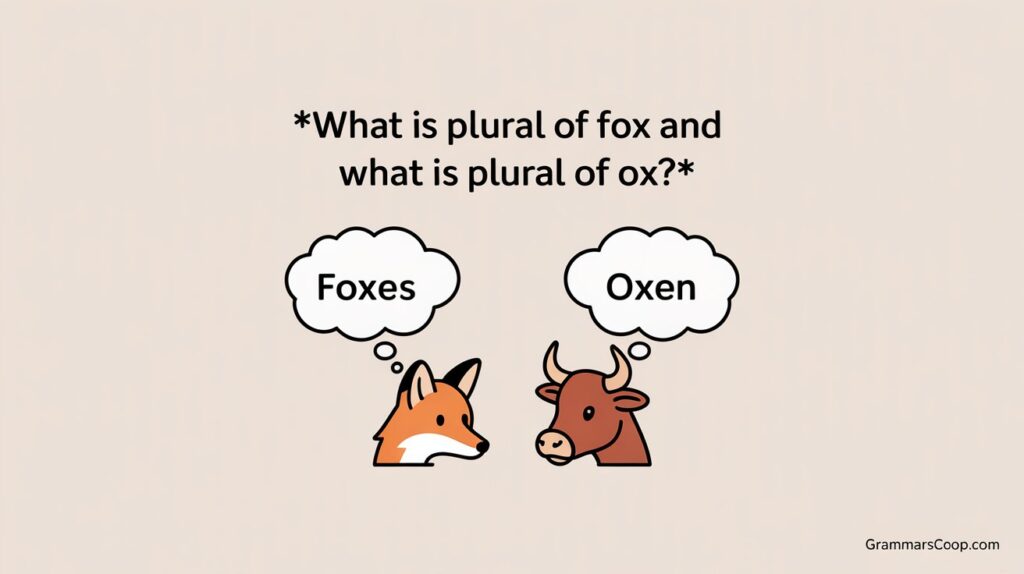Ever scratched your head wondering why we say “oxen” but not “foxen”? Or questioned why “foxes” gets a standard plural while “ox” throws a curveball? You’re not alone. What is Plural of Fox and What is Plural of Ox?? Is a surprisingly common question for English learners and native speakers alike. Let’s dig into the grammar, history, and logic behind these fascinating animal names.
Quick Summary
The plural of ox is oxen, and the plural of fox is foxes. These words may sound similar, but their plural forms come from very different places in the English language. “Oxen” is an irregular plural rooted in Old English, where some words took -en endings instead of the usual -s or -es. On the other hand, “foxes” follows the standard rule for forming plurals of words that end in -x—just add -es. While both animals are common in everyday language, their plurals highlight the quirks and evolution of English grammar rules over time.

Understanding the Singular Forms: Ox and Fox
Before we go plural, let’s start singular.
Ox
- Definition: A large domesticated bovine animal used for labor, especially in farming.
- Category: Livestock/working animal
- Example: The ox pulled the heavy cart through the mud.
Fox
- Definition: A small, wild animal known for its cunning nature and bushy tail.
- Category: Wild animal/canine family
- Example: A red fox darted across the snowy field.
While both are nouns and animals, their origins and uses vary greatly—which directly affects their plural forms.
The Plural Forms Explained: Foxes and Oxen
This is where the plot thickens. Most English plurals are made by simply adding “-s” or “-es” to the word. But not all nouns play by the rules.
Fox → Foxes (Regular Plural)
- Rule: Add -es to nouns ending in -x, -s, -sh, -ch, or -z.
- Why? To preserve pronunciation. “Foxs” would be awkward to say.
- Examples:
- I saw three foxes in the forest.
- Foxes are known for their intelligence.
Foxes plural follows a predictable, phonetic rule common in modern English.
Ox → Oxen (Irregular Plural)
- Rule: Some English nouns use the ancient -en ending, not “-s”.
- Origin: Old English “oxa” (singular), “oxan” (plural)
- Examples:
- The oxen were yoked together for plowing.
- A herd of oxen rested in the barn.
This oxen plural form is a linguistic fossil from a time when English was closer to Old German.
Why Are Their Plurals Different? (Etymology & Grammar)
Understanding why “oxen” and “foxes” use different plural forms requires a dive into etymology and English language evolution.
Historical Roots
- Ox comes from Old English “oxa” with a plural “oxan”.
- Fox also comes from Old English “fox” with a plural “foxas”.
So what happened?
- Over time, most Old English plurals switched to the standard -s/-es form.
- A few survivors like “oxen”, “children”, and “brethren” kept their irregular endings.
Linguist’s Note: The -en plural was once common. Examples:
- Child → Children
- Brother → Brethren (archaic)
- Cow → Kine (obsolete plural)
Phonetics and Standardization
Foxes follow modern spelling and pronunciation rules:
- Ends in a sibilant sound (“x” = /ks/)
- Needs “-es” for clarity in speech
Oxen, however, is a grammatical outlier:
- Rooted in history and tradition
- Retained for its strong cultural and academic familiarity
Common Mistakes and Confusions
Even native speakers get tripped up. Here are some frequent errors:
“Oxes” — Incorrect
- While logical, it’s grammatically wrong.
- Oxen is the correct plural of ox.
“Foxen” — Archaic Joke or Mistake
- Sometimes used playfully, especially in fantasy fiction (like Tolkien)
- Not correct in formal English
Plural vs. Possessive Confusion
- “The fox’s tail” (possessive)
- “Three foxes” (plural)
- Be sure not to mix the apostrophes!
Spelling Trouble
- “Foxs” (wrong)
- “Foxes” (right)
- “Oxens” (wrong)

Real-Life Examples in Sentences
Here’s how to use both correctly:
| Singular | Plural | Sentence Example |
|---|---|---|
| Ox | Oxen | The oxen worked the fields all day. |
| Fox | Foxes | Foxes are rarely seen during daylight. |
Fun Fact:
In the English Bible (King James Version), the word oxen appears more than 100 times, reinforcing its linguistic legitimacy.
Summary: Quick Reference Table
Here’s a handy guide to remember:
| Word | Plural Form | Type of Plural | Reason |
|---|---|---|---|
| Ox | Oxen | Irregular | Old English / Germanic plural |
| Fox | Foxes | Regular | Follows -es rule for words ending in -x |
Other Irregular Plurals in English (Like Oxen)
English has quite a few other nouns that don’t follow standard rules. Here are some examples:
| Singular | Plural | Rule Type |
|---|---|---|
| Child | Children | Irregular -en |
| Tooth | Teeth | Vowel change |
| Mouse | Mice | Vowel change |
| Goose | Geese | Vowel change |
| Man | Men | Vowel change |
These words, like ox, come from Old English and have retained their historic plural forms.
How to Remember Irregular Plural Forms
Tips to keep them straight:
- Group them into categories (vowel change, -en ending, unchanged)
- Use mnemonics: “Children chew teeth with mice”
- Read them in context
- Use visual charts like flashcards or infographics
“Irregular plurals are like family traditions: they don’t always make sense, but they stick.”
Explore further:
- Preexisting or Pre-Existing: Which One is Correct?
- Plural of Journey: Is It Journeys or Journies?
- Liter or Litre: Spelling Differences and When to Use Each
- Agreeance vs Agreement: Which One to Use?
- What’s the Plural of Iris? Explanation with Examples
Grammar Exceptions: Why Some Words Break the Rules
English evolved from many languages—Latin, Germanic, Norse, and French.
- Morphology (word structure) often clashes across origins.
- Some rules stuck from Old English plural forms.
- Others adapted as English standardized after the Norman invasion.
This mix is why we have logical words like books and weird ones like oxen.
Pronunciation Guide
- Foxes: /ˈfɑːksɪz/
- Oxen: /’ɒksən/
Both are easy to pronounce once you hear them. Saying “oxes” or “foxs” may sound off because it violates these rhythms.
Language Learner Tips
For ESL (English as a Second Language) learners:
- Memorize common irregular plurals
- Practice speaking them aloud
- Use them in full sentences to reinforce learning
FAQs
- What is the plural of fox and ox?
Fox becomes foxes, a regular plural.
Ox becomes oxen, an irregular plural.
- What is a plural for ox?
The correct form is oxen.
- How to write fox plural?
Add -es to get foxes.
- What is the difference between a fox and an ox?
A fox is a wild carnivorous mammal; a ox is a domesticated bovine often used for farm work.
- Ox ka plural kya hai?
English mein “ox” ka plural oxen hota hai. “Oxes” galat hai.
Final Thoughts
So now you know: What Are the Plurals of ‘Ox’ and ‘Fox’? isn’t just a grammar question—it’s a peek into the history of English itself. The plural of ox is oxen, a rare survivor of ancient rules. The plural of fox is foxes, a perfect example of modern language logic.
These aren’t just animals. They’re lessons in etymology, evolution, and exception. And knowing them makes your grammar sharper and your language learning journey smoother.

Lisa Morris is a seasoned blogger and language enthusiast with a passion for making grammar simple and engaging. At Grammar Scoop, she shares clear, concise tips that help readers master the rules of English with confidence.






